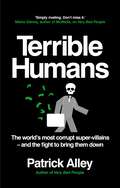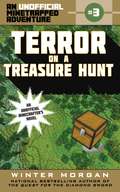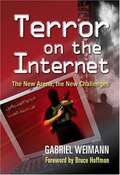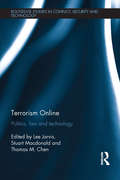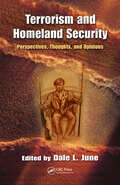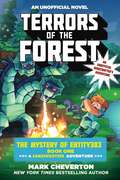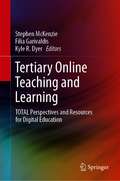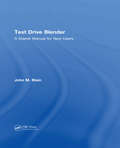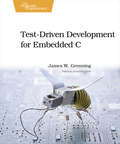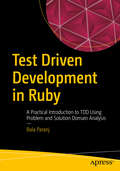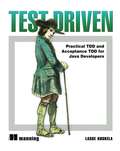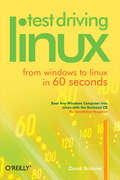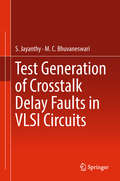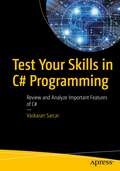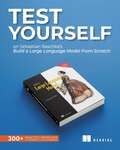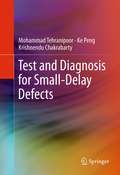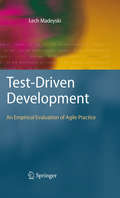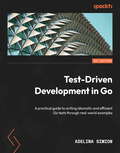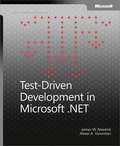- Table View
- List View
Terrible Humans: The World's Most Corrupt Super-Villains And The Fight to Bring Them Down
by Patrick Alley'Few people have shown more commitment to investigative journalism than Patrick Alley. His latest book is a vivid, compelling testament to the importance of revealing corruption and wrong-doing and shining a light into dark places, wherever in the world they are.' -Peter Geoghegan, author of Democracy for SaleA small number of people, motivated by an insatiable greed for power and wealth, and backed by a pinstripe army of enablers (and sometimes real armies too), have driven the world to the brink of destruction. They are the super-villains of corruption and war, some with a power greater than nation state and the capacity to derail the world order. Propping up their opulent lifestyles is a mess of crime, violence and deception on a monumental scale. But there is a fightback: small but fearless groups of brilliant undercover sleuths closing in on them, one step at a time.In Terrible Humans, Patrick Alley, co-founder of Global Witness and the author of Very Bad People, introduces us to some of the world's worst warlords, grifters and kleptocrats who can be found everywhere from presidential palaces to the board rooms of some of the world's best known companies. Pitted against them, the book also follows the people unravelling the deals, tracking the money and going undercover at great risk. From the oligarch charged with ordering the killing of an investigative journalist to the mercenary army seizing the natural resources of an entire African country, this is a whirlwind tour of the dark underbelly of the world's super powerful and wickedly wealthy, and the daring investigators dragging them into the light.***PRAISE FOR Very Bad People:'Reads like a John le Carré novel but is, in fact, very real.' -The Big Issue'Part true crime tale, part investigative procedural, this is the account of the brilliant and necessary superheroes of Global Witness, whose superpower is the truth.' -Edward Zwick, Director of Blood Diamond'Very Bad People reads like a non-stop high-speed chase' -David Farr, Screenwriter, The Night Manager'Simply riveting. Don't miss it.' -Misha Glenny, author of McMafia'A clear-eyed account of a world poisoned by dark money, and a welcome reminder that resistance is possible.' -Irish Times
Terror on a Treasure Hunt: An Unofficial Minetrapped Adventure, #3 (The Unofficial Minetrapped Adventure #3)
by Winter MorganAfter trapping Mr. Anarchy, the evil master griefer who’s been tormenting them, Lily, Simon, and Michael can finally concentrate on trying to escape the Overworld and getting to know their new friends on the server. So when one of their friends invites them along on a treasure hunt, they couldn’t be more thrilled!But when the gang’s absence from Lisimi Village gives Mr. Anarchy a chance to escape, their hunt for treasure is cut short and Lily, Simon, and Michael must make a hard decision: do they continue their much-anticipated treasure hunt, or do they band together with their new friends to find and recapture Mr. Anarchy, and whatever team of griefers he might be working with?Nothing is as it seems-and no one can be trusted-in this thrilling third book in bestselling author Winter Morgan’s Unofficial Minetrapped Adventure series.Sky Pony Press, with our Good Books, Racehorse and Arcade imprints, is proud to publish a broad range of books for young readers-picture books for small children, chapter books, books for middle grade readers, and novels for young adults. Our list includes bestsellers for children who love to play Minecraft; stories told with LEGO bricks; books that teach lessons about tolerance, patience, and the environment, and much more. In particular, this adventure series is created especially for readers who love the fight of good vs. evil, magical academies like Hogwarts in the Harry Potter saga, and games like Minecraft, Terraria, and Pokemon GO. While not every title we publish becomes a New York Times bestseller or a national bestseller, we are committed to books on subjects that are sometimes overlooked and to authors whose work might not otherwise find a home.
Terror on the Internet: The New Arena, The New Challenges
by Bruce Hoffman Gabriel WeimannDrawing on a seven-year study of the World Wide Web and a wide variety of literature, the author examines how modern terrorist organizations exploit the Internet to raise funds, recruit, and propagandize, as well as to plan and launch attacks and to publicize their chilling results.
Terrorism Online: Politics, Law and Technology (Routledge Studies in Conflict, Security and Technology)
by Thomas M. Chen Lee Jarvis Stuart MacDonaldThis book investigates the intersection of terrorism, digital technologies and cyberspace. The evolving field of cyber-terrorism research is dominated by single-perspective, technological, political, or sociological texts. In contrast, Terrorism Online uses a multi-disciplinary framework to provide a broader introduction to debates and developments that have largely been conducted in isolation. Drawing together key academics from a range of disciplinary fields, including Computer Science, Engineering, Social Psychology, International Relations, Law and Politics, the volume focuses on three broad themes: 1) how – and why – do terrorists engage with the Internet, digital technologies and cyberspace?; 2) what threat do these various activities pose, and to whom?; 3) how might these activities be prevented, deterred or addressed? Exploring these themes, the book engages with a range of contemporary case studies and different forms of terrorism: from lone-actor terrorists and protest activities associated with ‘hacktivist’ groups to state-based terrorism. Through the book’s engagement with questions of law, politics, technology and beyond, the volume offers a holistic approach to cyberterrorism which provides a unique and invaluable contribution to this subject matter. This book will be of great interest to students of cybersecurity, security studies, terrorism and International Relations.
Terrorism and Homeland Security: Perspectives, Thoughts, and Opinions
by Dale L. JuneSince 9/11, the terms homeland security and terrorism have become firmly entrenched in our lexicon. The days of walking through a simple metal detector at the airport are over, and our security landscape is forever changed. Terrorism and Homeland Security: Perspectives, Thoughts, and Opinions brings together the work of academic researchers and law
Terrorism and State Surveillance of Communications
by David Lowe Simon Hale-RossThis book brings together leading counterterrorism experts, from academia and practice, to form an interdisciplinary assessment of the terrorist threat facing the United Kingdom and the European Union, focusing on how terrorists and terrorist organisations communicate in the digital age. Perspectives drawn from criminological, legalistic, and political sciences, allow the book to highlight the problems faced by the state and law enforcement agencies in monitoring, accessing, and gathering intelligence from the terrorist use of electronic communications, and how such powers are used proportionately and balanced with human rights law. The book will be a valuable resource for scholars and students of terrorism and security, policing and human rights. With contributions from the fields of both academia and practice, it will also be of interest to professionals and practitioners working in the areas of criminal law, human rights and terrorism.
Terrorist Recruitment, Propaganda and Branding: Selling Terror Online (Political Violence)
by Anna KruglovaThis book analyses the marketing techniques that terrorist organisations employ to encourage people to adopt their ideology and become devoted supporters. The book’s central thesis is that due to the development of digital technologies and social media, terrorist groups are employing innovative marketing techniques and advertising strategies to foster an emotional connection with their audiences, particularly those in younger demographics. By conducting thematic and narrative analyses of Islamic State of Iraq and Syria (ISIS) propagandist magazines, as well as looking at the group’s online communities, the book demonstrates that terrorist groups behave as commercial brands by establishing an emotional connection with their potential recruits. Specifically, groups and their potential supporters follow the logic of emotional choice. The book emphasizes that while ISIS became the first group that discovered and benefited from the power of marketing, it did not have a supernatural power and thus it is possible to find a response to it, which is particularly important now. The book eventually poses a question about whether terrorism has become the product of marketing in the same way as any mainstream consumer product is, and asks what can we do to battle the appeal of marketing-savvy terrorist groups. This book will be of interest to students of terrorism studies, radicalisation, and propaganda, communication , and security studies.
Terrorist Use of Cryptocurrencies: Technical and Organizational Barriers and Future Threats
by Cynthia Dion-Schwarz David Manheim Johnston, Patrick B.The success of counterterrorism finance strategies in reducing terrorist access to official currencies has raised concerns that terrorist organizations might increase their use of such digital cryptocurrencies as Bitcoin to support their activities. RAND researchers thus consider the needs of terrorist groups and the advantages and disadvantages of the cryptocurrency technologies available to them.
Terrors of the Forest: The Mystery of Entity303 Book One: A Gameknight999 Adventure: An Unofficial Minecrafter?s Adventure (Gameknight999 Series #1)
by Mark ChevertonGameknight999 reenters Minecraft to find it completely changed. There are new monsters that he’s never seen before: giants and skeleton druids and pinch beetles and king spiders and mistwolves. Villages are larger than ever, and more heavily fortified; Minecraft had become much more dangerous. Even the very trees had changed, with some of them reaching up taller than the User-that-is-not-a-user ever thought was imaginable.There’s a diamond block portal outside of Crafter’s village, and rumors are spreading that a strange user was seen coming out of the portal with a young boy, before they disappeared into another portal, leaving behind a square hole one block deep with a ring of flowers around it. Gameknight recognizes it as the portal to reach the Twilight Forest mod. But how can there be mods here in the vanilla Minecraft?The User-that-is-not-a-user follows the trail, and finds odd mentions of "303” and "White Castle.” But what do the clues mean? Just how dangerous is this new user to Minecraft, and where is he taking the young NPC? Only Gameknight999 will be able to find out.Sky Pony Press, with our Good Books, Racehorse and Arcade imprints, is proud to publish a broad range of books for young readers-picture books for small children, chapter books, books for middle grade readers, and novels for young adults. Our list includes bestsellers for children who love to play Minecraft; stories told with LEGO bricks; books that teach lessons about tolerance, patience, and the environment, and much more. While not every title we publish becomes a New York Times bestseller or a national bestseller, we are committed to books on subjects that are sometimes overlooked and to authors whose work might not otherwise find a home.
Tertiary Online Teaching and Learning: TOTAL Perspectives and Resources for Digital Education
by Kyle R. Dyer Stephen McKenzie Filia GarivaldisThis book is the first comprehensive and integrated guide to online education. It systematically presents all aspects of the emerging “big picture” of online education, providing a broad range of information and insights from online experts, learners, teachers, developers and researchers.The book introduces readers to online education and reveals its potential for bringing about a paradigm shift in education. It describes avenues for increasing the value of the online education medium and examines techniques for improving the online student experience. It also offers a wealth of real-world examples and experiences and shares recommendations on how to improve them, provided by students, teachers, developers, and researchers.Accordingly, the book equips readers – including online learners, teachers, researchers, developers, and administrators – to optimally participate in and contribute to current and future online education advances.
Test Automation Engineering Handbook: Learn and implement techniques for building robust test automation frameworks
by Manikandan SambamurthyUnderstand test automation and implement it in Web, Mobile, and APIs effectivelyKey FeaturesLearn how to automate your tests with the help of practical examplesUnderstand how to bridge the gap between testing and test automationExplore test automation strategies for different platformsBook DescriptionThis book helps you build a better understanding of test automation and aids in bridging the gap between testing and test automation.The book has been divided into three sections with the first section focusing on preparing you for testing and test automation fundamentals. By the end of this section, you'll have an understanding of some common automation terms, definitions, and roles. The second section covers the practical implementation of test automation for mobile, web, API and performance. The third section will help you understand how test automation works with CI/CD, and explore the common issues and pitfalls when executing test automation.By the end of this book, you'll have a better understanding of automation, addressing the common pain points and best practices around test automation.What you will learnGain a solid understanding of test automationUnderstand how automation fits into a test strategyExplore essential design patterns for test automationDesign and implement highly reliable automated testsUnderstand issues and pitfalls when executing test automationDiscover the commonly used test automation tools/frameworksWho this book is forThis book is for manual testers who want to enter the field of test automation and developers who want to learn more about test automation.
Test Drive Blender: A Starter Manual for New Users
by John M. BlainThis book will introduce you to the controls and steer you towards understanding what Blender can do. With this program you can create 3D models of objects and characters. The objects and characters can be placed in scenes. The scenes are captured by camera and rendered into digital images. The objects and characters can be animated and then, again, captured by camera and rendered to video files. Video files can then be compiled into movies. This book will show you how to make the Blender program go through some of its paces and give you an insight into this fantastic world. You will be shown the controls and given operation instructions allowing you to activate a variety of features.
Test Driven Development for Embedded C (Pragmatic Bookshelf Ser.)
by James W. GrenningAnother day without Test-Driven Development means more time wasted chasing bugs and watching your code deteriorate. You thought TDD was for someone else, but it's not! It's for you, the embedded C programmer. TDD helps you prevent defects and build software with a long useful life. This is the first book to teach the hows and whys of TDD for C programmers.TDD is a modern programming practice C developers need to know. It's a different way to program---unit tests are written in a tight feedback loop with the production code, assuring your code does what you think. You get valuable feedback every few minutes. You find mistakes before they become bugs. You get early warning of design problems. You get immediate notification of side effect defects. You get to spend more time adding valuable features to your product.James is one of the few experts in applying TDD to embedded C. With his 1.5 decades of training,coaching, and practicing TDD in C, C++, Java, and C# he will lead you from being a novice in TDD to using the techniques that few have mastered.This book is full of code written for embedded C programmers. You don't just see the end product, you see code and tests evolve. James leads you through the thought process and decisions made each step of the way. You'll learn techniques for test-driving code right nextto the hardware, and you'll learn design principles and how to apply them to C to keep your code clean and flexible.To run the examples in this book, you will need a C/C++ development environment on your machine, and the GNU GCC tool chain or Microsoft Visual Studio for C++ (some project conversion may be needed).
Test Driven Development in Ruby
by Bala ParanjLearn the basics of test driven development (TDD) using Ruby. You will carry out problem domain analysis, solution domain analysis, designing test cases, and writing tests first. These fundamental concepts will give you a solid TDD foundation to build upon. Test Driven Development in Ruby is written by a developer for developers. The concepts are first explained, then a coding demo illustrates how to apply the theory in practice. At the end of each chapter an exercise is given to reinforce the material. Complete with working files and code samples, you'll be able to work alongside the author, a trainer, by following the material in this book. What You Will Learn Carry out problem domain analysis, solution domain analysis, designing test cases, and writing tests first Use assertions Discover the structure of a test and the TDD cycle Gain an understanding of minimal implementation, starter test, story test, and next test Handle refactoring using Ruby Hide implementation details Test precisely and concretely Make your code robust Who This Book Is For Experienced Ruby programmers or web developers with some prior experience with Ruby.
Test Driven: Practical TDD and Acceptance TDD for Java Developers
by Lasse KoskelaIn test driven development, you first write an executable test ofwhat your application code must do. Only then do you write thecode itself and, with the test spurring you on, you improve yourdesign. In acceptance test driven development (ATDD), you usethe same technique to implement product features, benefiting fromiterative development, rapid feedback cycles, and better-definedrequirements. TDD and its supporting tools and techniques leadto better software faster.Test Driven brings under one cover practical TDD techniquesdistilled from several years of community experience. With examplesin Java and the Java EE environment, it explores both the techniquesand the mindset of TDD and ATDD. It uses carefully chosen examplesto illustrate TDD tools and design patterns, not in the abstractbut concretely in the context of the technologies you face at work.It is accessible to TDD beginners, and it offers effective and less wellknown techniques to older TDD hands. Purchase of the print book comes with an offer of a free PDF, ePub, and Kindle eBook from Manning. Also available is all code from the book. What's InsideLearn hands-on to test drive Java codeHow to avoid common TDD adoption pitfallsAcceptance test driven development and the Fit frameworkHow to test Java EE components-Servlets, JSPs, and SpringControllersTough issues like multithreaded programs and data access code
Test Driving Linux
by David BricknerFor years, computer users have put up with the bugs, security holes, and viruses on Windows because they had no choice. Until recently, there has never been a good alternative to Windows. But now, Windows users can switch to Linux, the reliable, secure, and spyware free operating system. Linux is easy to use, runs on almost any PC, and enables you to perform all the tasks you can do with Windows. Getting to know Linux has never been easier, because now there's a way to test-drive Linux without changing, installing, or configuring a thing on your computer. It's called Test Driving Linux: From Windows to Linux in 60 Seconds. This latest release from O'Reilly comes with a Live CD called Move, that allows Windows users to try all the features of Mandrake Linux, a popular Linux distribution without the hassle of actually installing Linux. Users simply place the Move CD into their CD drive, boot from the disc, then watch an entire Mandrake system run on the fly from the CD-ROM. Test Driving Linux: From Windows to Linux in 60 Seconds is a detailed step-by-step guide to the Linux operating system and several popular open source programs. With this guide you can quickly learn how to use Linux to perform the tasks you do most: surf the web, send and receive email, instant message with friends, write letters, create spreadsheets, and even how to enhance your digital photos. Test Driving Linux: From Windows to Linux in 60 Seconds provides both home and business users with a hassle-free way to investigate this operating system before they purchase and install a complete Linux distribution.
Test Generation of Crosstalk Delay Faults in VLSI Circuits
by M. C. Bhuvaneswari S. JayanthyThis book describes a variety of test generation algorithms for testing crosstalk delay faults in VLSI circuits. It introduces readers to the various crosstalk effects and describes both deterministic and simulation-based methods for testing crosstalk delay faults. The book begins with a focus on currently available crosstalk delay models, test generation algorithms for delay faults and crosstalk delay faults, before moving on to deterministic algorithms and simulation-based algorithms used to test crosstalk delay faults. Given its depth of coverage, the book will be of interest to design engineers and researchers in the field of VLSI Testing.
Test Your Skills in C# Programming: Review and Analyze Important Features of C#
by Vaskaran SarcarReview the fundamental constructs in C# using Q&As and program segments to boost your confidence and gain expertise. This book will help you analyze your programs more efficiently and enhance your programming skills.The book is divided into three parts, where you will learn the fundamentals, object-oriented programming, and some advanced features of C#. In the first part, you will review C# and .NET basics along with the important constructs such as strings, arrays, and structures. In the second part, you'll review the concepts of object-oriented programming in detail. Here, you will go through various program segments in class and objects, inheritance, polymorphism, abstraction, encapsulation, and much more. You will also analyze the output of the given programs with the help of Q&A sections. The uses of interfaces, static class, and exception handling are discussed in the book along with some other important concepts in C#. In the third and last part, you will learn advanced features of C# programming such as delegates, events, lambdas, generics, and multithreading. Here, you'll also cover some of the latest features of C#.After reading this book, you will be able to analyze and apply the basic and frequently used features along with the advanced features of C#. What Will You LearnUnderstand the core and some of the latest features in C#Review your programming skills along with some of the latest features in C#Know how object-oriented programming (OOP) is used in C#Get up and running on the advanced features of C# such as delegates, lambdas, generics, and moreWho This Is Book ForProgrammers with basic knowledge of C#
Test Yourself On Build a Large Language Model (From Scratch)
by Curated From Build A Large Language ModelSebastian Raschka&’s bestselling book Build a Large Language Model (From Scratch) is the best way to learn how Large Language Models function. Summary With over 350 pages in seven chapters and five Appendixes, it guides you step-by-step in building an entire large language model similar to GPT-2. It uses Python and the PyTorch deep learning library. It&’s a unique way to learn this subject, which some believe is the only way to truly learn: you build a model yourself. Even with the clear explanations, diagrams, and code in the book, learning a complex subject is still hard. This Test Yourself guide intends to make it a little easier. The structure mirrors the structure of Build a Large Language Model (From Scratch), focusing on key concepts from each chapter. You can test yourself with multiple-choice quizzes, questions on code and key concepts, and questions with longer answers that push you to think critically. The answers to all questions are provided. Depending on what you know at any point, this Test Yourself guide can help you in different ways. It will solidify your knowledge if used after reading a chapter. But it will also benefit you if you digest it before reading. By testing yourself on the main concepts and their relationships you are primed to navigate a chapter more easily and be ready for its messages. We recommend using it before and after reading, as well as later when you have started forgetting. Repeated learning solidifies our knowledge and integrates it with related knowledge already in our long-term memory. What's inside • Questions on code and key concepts • Critical thinking exercises requiring longer answers • Answers for all questions About the reader For readers of Build a Large Language Model (From Scratch) who want to enhance their learning with exercises and self-assessment tools. About the author Curated from Build a Large Language Model (From Scratch).
Test Yourself On Build a Large Language Model (From Scratch): Exercises to Enhance your LLM Learning
by Download Your Free Companion GuideLearn how to create, train, and tweak large language models (LLMs) by building one from the ground up!Sebastian Raschka&’s bestselling book Build a Large Language Model (From Scratch) is the best way to learn how Large Language Models function. It uses Python and the PyTorch deep learning library. It&’s a unique way to learn this subject, which some believe is the only way to truly learn: you build a model yourself. Even with the clear explanations, diagrams, and code in the book, learning a complex subject is still hard. This Test Yourself guide intends to make it a little easier. The structure mirrors the structure of Build a Large Language Model (From Scratch), focusing on key concepts from each chapter. You can test yourself with multiple-choice quizzes, questions on code and key concepts, and questions with longer answers that push you to think critically. The answers to all questions are provided. Depending on what you know at any point, this Test Yourself guide can help you in different ways. It will solidify your knowledge if used after reading a chapter. But it will also benefit you if you digest it before reading. By testing yourself on the main concepts and their relationships you are primed to navigate a chapter more easily and be ready for its messages. We recommend using it before and after reading, as well as later when you have started forgetting. Repeated learning solidifies our knowledge and integrates it with related knowledge already in our long-term memory. What's inside • Questions on code and key concepts • Critical thinking exercises requiring longer answers • Answers for all questions About the reader For readers of Build a Large Language Model (From Scratch) who want to enhance their learning with exercises and self-assessment tools. About the author Curated from Build a Large Language Model (From Scratch)
Test and Diagnosis for Small-Delay Defects
by Mohammad Tehranipoor Krishnendu Chakrabarty Ke PengThis book will introduce new techniques for detecting and diagnosing small-delay defects in integrated circuits. Although this sort of timing defect is commonly found in integrated circuits manufactured with nanometer technology, this will be the first book to introduce effective and scalable methodologies for screening and diagnosing small-delay defects, including important parameters such as process variations, crosstalk, and power supply noise.
Test-Driven Development
by Lech MadeyskiAgile methods are gaining more and more interest both in industry and in research. Many industries are transforming their way of working from traditional waterfall projects with long duration to more incremental, iterative and agile practices. At the same time, the need to evaluate and to obtain evidence for different processes, methods and tools has been emphasized. Lech Madeyski offers the first in-depth evaluation of agile methods. He presents in detail the results of three different experiments, including concrete examples of how to conduct statistical analysis with meta analysis or the SPSS package, using as evaluation indicators the number of acceptance tests passed (overall and per hour) and design complexity metrics. The book is appropriate for graduate students, researchers and advanced professionals in software engineering. It proves the real benefits of agile software development, provides readers with in-depth insights into experimental methods in the context of agile development, and discusses various validity threats in empirical studies.
Test-Driven Development in Go: A practical guide to writing idiomatic and efficient Go tests through real-world examples
by Adelina SimionExplore Go testing techniques and leverage TDD to deliver and maintain microservices architecture, including contract, end-to-end, and unit testingPurchase of the print or Kindle book includes a free PDF eBookKey FeaturesWrite Go test suites using popular mocking and testing frameworksLeverage TDD to implement testing at all levels of web applications and microservices architectureMaster the art of writing tests that cover edge cases and concurrent codeBook DescriptionExperienced developers understand the importance of designing a comprehensive testing strategy to ensure efficient shipping and maintaining services in production. This book shows you how to utilize test-driven development (TDD), a widely adopted industry practice, for testing your Go apps at different levels. You'll also explore challenges faced in testing concurrent code, and learn how to leverage generics and write fuzz tests.The book begins by teaching you how to use TDD to tackle various problems, from simple mathematical functions to web apps. You'll then learn how to structure and run your unit tests using Go's standard testing library, and explore two popular testing frameworks, Testify and Ginkgo. You'll also implement test suites using table-driven testing, a popular Go technique. As you advance, you'll write and run behavior-driven development (BDD) tests using Ginkgo and Godog. Finally, you'll explore the tricky aspects of implementing and testing TDD in production, such as refactoring your code and testing microservices architecture with contract testing implemented with Pact. All these techniques will be demonstrated using an example REST API, as well as smaller bespoke code examples.By the end of this book, you'll have learned how to design and implement a comprehensive testing strategy for your Go applications and microservices architecture.What you will learnCreate practical Go unit tests using mocks and assertions with TestifyBuild table-driven test suites for HTTP web applicationsWrite BDD-style tests using the Ginkgo testing frameworkUse the Godog testing framework to reliably test web applicationsVerify microservices architecture using Pact contract testingDevelop tests that cover edge cases using property testing and fuzzingWho this book is forIf you are an intermediate-level developer or software testing professional who knows Go fundamentals and is looking to deliver projects with Go, then this book is for you. Knowledge of Go syntax, structs, functions, and interfaces will help you get the most out of this book.
Test-Driven Development in Microsoft® .NET
by James W. Newkirk Alexei A. VorontsovWith the clarity and precision intrinsic to the Test-Driven Development (TDD) process itself, experts James Newkirk and Alexei Vorontsov demonstrate how to implement TDD principles and practices to drive lean, efficient coding--and better design. The best way to understand TDD is to see it in action, and Newkirk and Vorontsov walk step by step through TDD and refactoring in an n-tier, .NET-connected solution. And, as members of the development team for NUnit, a leading unit-testing framework for Microsoft .NET, the authors can offer matchless insights on testing in this environment--ultimately making their expertise your own. Test first--and drive ambiguity out of the development process: Document your code with tests, rather than paper Use test lists to generate explicit requirements and completion criteria Refactor--and improve the design of existing code Alternate programmer tests with customer tests Change how you build UI code--a thin layer on top of rigorously tested code Use tests to make small, incremental changes--and minimize the debugging process Deliver software that's verifiable, reliable, and robust
Test-Driven Development in Microsoft® .NET
by Alexei Vorontsov James Newkirk<div xmlns="http://www.w3.org/1999/xhtml"><p>Apply the concepts and techniques of Test-Driven Development to building Microsoft .NET connected applications. Two experts in agile software development demonstrate by example how to use tests to drive lean, efficient coding and better design.</p></div>
